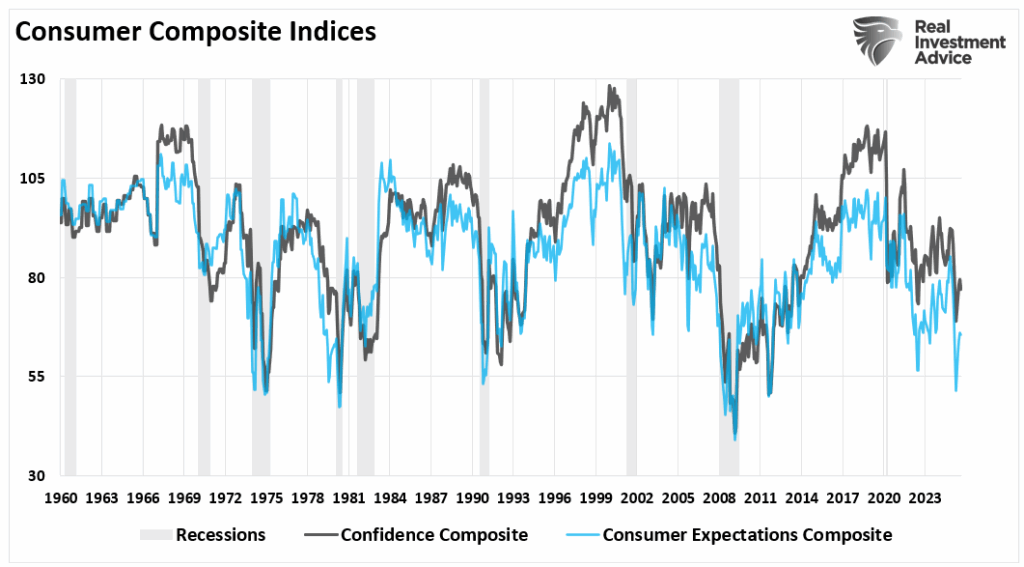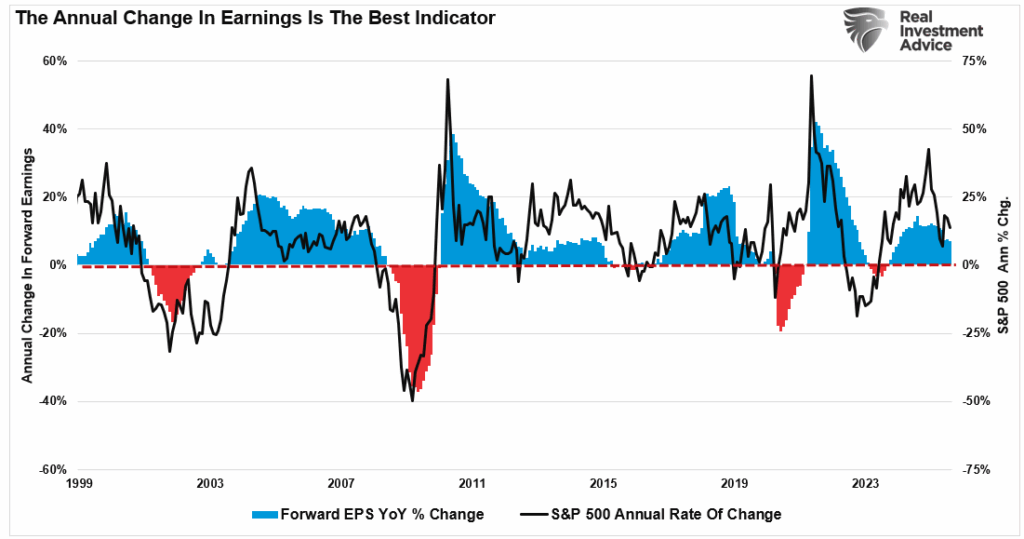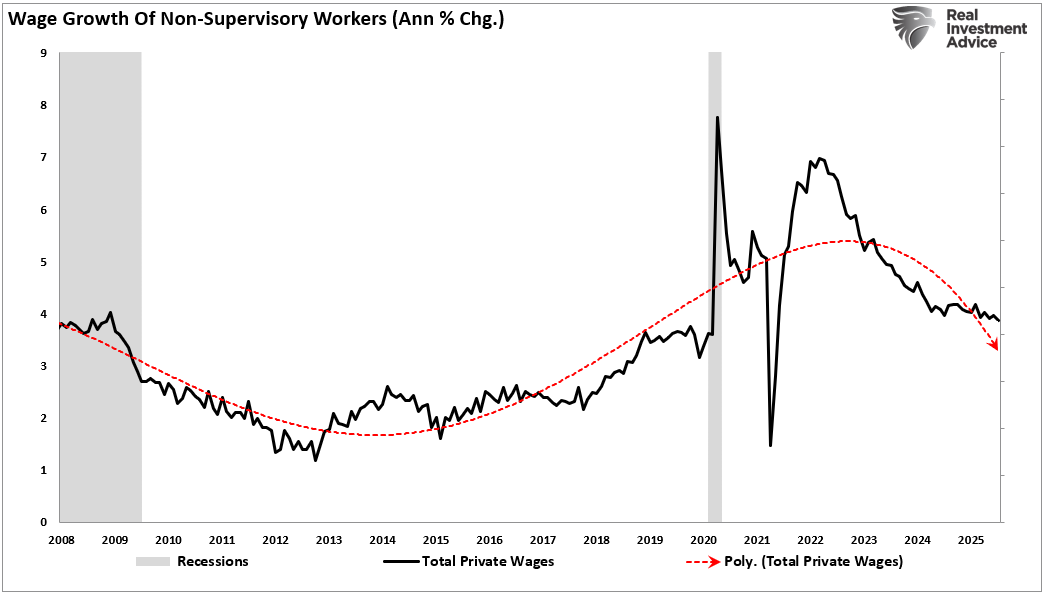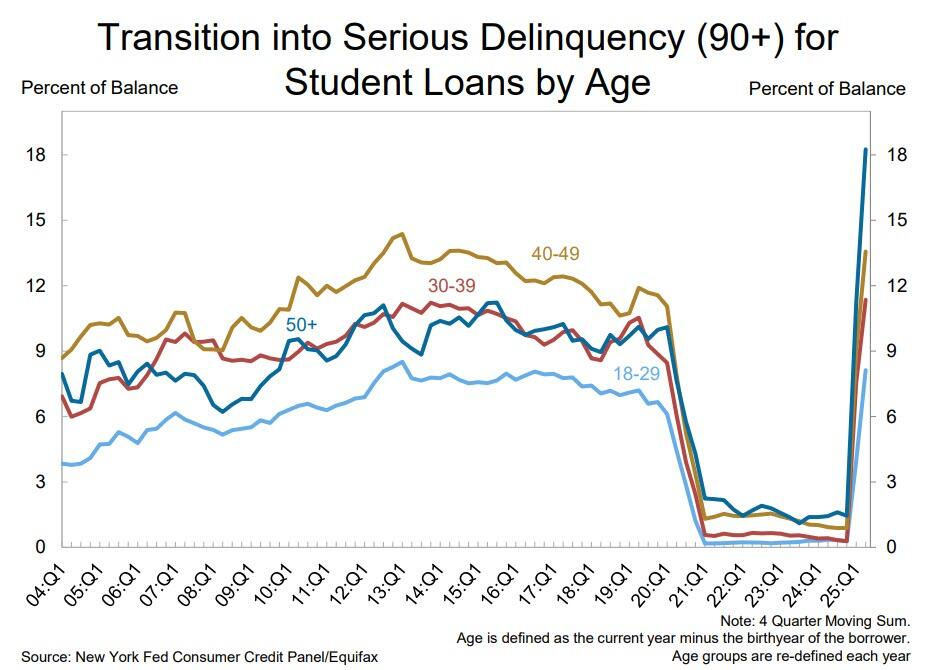Qantas shares slide to 6-mth low as airline trims revenue outlook
The latest economic data suggests the US economy is decelerating. That means growth is slowing, jobs are shrinking, and households are spending less. As we showed in a recent #BullBearReport, economic growth, inflation, and personal consumption are trending lower.

Unsurprisingly, with job growth weakening, consumer sentiment also took a hit in the latest report, with future expectations remaining very weak.
While the financial markets got very excited over the data, as it creates pressure for rate cuts in the US, it bodes poorly for future returns. So far in 2025, there have been 88 central bank rate cuts, the fastest cut cycle since the 2020 COVID crash. That is not a sign of burgeoning economic growth. While stocks and credit anticipate the Fed joining the easing party, the pace of cuts suggests that weakness is spreading globally.
Crucially, economic growth, or the lack thereof, shapes earnings expectations and investor behavior. At first glance, it looked like the US economy was regaining strength in the latest GDP report. But the drivers of that growth tell a different story. Consumer spending rose 1.4 percent, the primary contributor.
However, this increase was funded mainly through savings depletion and increased credit usage. Real wage growth remained stagnant, which means consumers were not spending more because they earned more. They borrowed and spent their savings.
Another major contributor to Q2 GDP was a sharp drop in imports. While this technically boosts GDP, it is not indicative of economic health. Imports fell because domestic demand weakened, and tariffs continued to distort trade flows. Export growth was modest, but not enough to offset the larger picture of global trade deceleration.
Private fixed investment also declined in Q2, suggesting businesses are pulling back on capital expenditures, particularly equipment and structures. This signals reduced confidence in future demand. Inventory restocking added marginally to GDP, but with backlogs thinning and sales slowing, inventory reductions are likely in Q3 and Q4.
Furthermore, while investors are exceedingly bullish on the stock market, forecasts for the remainder of 2025 are sobering. Most projections now place US economic growth at 1.5 percent or lower in the second half. By Q4, real GDP growth could slow to below 1.0 percent year-over-year. Even the IMF, which recently produced its global growth estimates, has the US economy growing at 2% for the next two years, and the Eurozone near 1%.
As discussed above, consumer spending, the primary driver of GDP, will be constrained by slowing wage growth, high debt servicing costs, and reduced access to credit. The economy lacks alternative growth engines without a pick-up in business investment or export demand. That reduction in economic demand will translate into forward earnings expectations, requiring a revaluation of financial markets.
Let’s look at some of the most recent economic data to assess the risks.
US Economic Data: Good, Not Great
July’s employment report confirmed that the slowdown in US economic growth is taking root. Nonfarm payrolls increased by a mere 73,000 jobs. Expectations were for 110,000. The bigger story is in the revisions. May and June payrolls were slashed by 258,000. That’s the second-largest two-month downward revision since the 2008 recession. When employers stop hiring and previous gains get erased, that is not a data glitch—it’s a signal.
The unemployment rate increased to 4.2 percent, while labor force participation remained at 62.2 percent. While not alarming at face value, the lack of participation growth shows that the working-age population isn’t reentering the workforce in significant numbers.
More importantly, full-time employment remains weak as a percentage of total employees, which correlates to the future direction of personal consumption expenditures and inflation. Such is unsurprising given that for individuals to consume at higher levels, they need full-time employment. Without increases in consumption, US economic growth and inflation will decline.
Wage growth is also losing momentum. Average hourly earnings rose 0.3 percent month-over-month, but year-over-year gains slowed to 3.9 percent. This is a problem. Inflation is still hot in services and necessities, eroding real income growth.
Consequently, households feel the pinch, and discretionary spending will reflect that in the second half of 2025. Such is particularly the case with rising delinquency rates, particularly in student loan debt.
The sector breakdown of job growth shows late-cycle dynamics. Healthcare and government jobs are still being added, but these are non-cyclical. Manufacturing employment declined, reflecting weaker orders and global trade slowdowns. Professional and business services hiring has stalled.
Furthermore, the labor market is transitioning from a phase of post-pandemic recovery to a structurally slower employment cycle. Businesses are tightening labor expenses as revenue growth slows.
This is not a short-term adjustment; it’s a reset of hiring expectations across multiple sectors. If wage growth continues to moderate and hiring slows, the consumption-driven economy will lose its primary growth engine.
Data Reveals Broad-Based Slowdown
Outside the employment report, July’s ISM Manufacturing Index fell to 48.0, marking five months of contraction. New orders were sluggish, while the employment index plummeted to 43.4 percent. This reading is significant. It indicates companies are actively reducing factory jobs, not simply slowing hiring.
The problem is not isolated to manufacturing. The services sector, comprising roughly 70 percent of the U.S. economy, barely holds on. The ISM Services Index registered at 50.1 in July, down from a reading of 50.8 previously. This is technically an expansion reading, but only by the slimmest margin.
The composite index is economically weighted (70% services / 30% manufacturing). It tells us what we already suspected: that the economy is growing, albeit very slowly.
The employment component of services fell to 46.4 percent. When service firms start cutting payrolls, it signifies a more profound weakness in demand. For months, services spending was the buffer against manufacturing softness. That buffer is eroding as input costs have risen. Businesses face increasing operational expenses while revenue growth stagnates, a recipe for margin compression.
This was evident already in the Q2 earnings reporting period. There would have been no earnings growth without Megacap Technology and major Wall Street banks.
Industrial companies have already started guiding lower. Tariffs, higher input costs, and weakening orders are cutting into margins. Companies like Caterpillar (NYSE:CAT), Deere (NYSE:DE), and 3M (NYSE:MMM) have issued profit warnings. Consumer-facing companies are also vulnerable. Discretionary spending is slowing, and rising input costs will further squeeze margins for retailers and service providers.
While technology and AI-driven firms have recently become bright spots, their strength cannot offset broader corporate margin pressures. In Q2, S&P 500 earnings grew 6.4%, with 80 percent of companies beating estimates. But this masks a weakening breadth of growth, where earnings beats are concentrated in essentially just two sectors.
As noted, slowing economic growth will reduce earnings expectations for Q3 and Q4. Margin compression will dominate as companies with pricing power and efficient cost structures prosper while the rest struggle to meet expectations.
Investors must now consider this risk.
Investor Positioning in a Slowing Economy
The evidence points to a slowing US economy. Growth is weakening, inflation remains elevated, corporate margins face pressure, and interest rate cuts are likely. These conditions require a shift in investment strategy. Investors must adapt to preserve capital, generate income, and manage risk. Positioning should emphasize resilience, quality, and income stability. The goal is to reduce exposure to volatile sectors and concentrate on assets that perform well during economic slowdowns.
Here are key actions investors should consider:
- Reduce exposure to cyclical stocks: Cut back on discretionary sectors like retail, travel, and consumer electronics that rely heavily on strong economic growth.
- Increase allocation to defensive sectors: Focus on consumer staples, healthcare, and utilities. These sectors provide stable earnings even in weak environments.
- Favor companies with strong pricing power: These firms can better maintain margins despite rising input costs.
- Prioritize strong balance sheets: Low debt and high cash reserves reduce financial stress and support consistent returns.
- Add high-quality dividend payers: Look for companies with a track record of stable or growing dividends. These provide income support as capital gains slow.
- Increase fixed income exposure: Short-duration bonds and high-grade corporates may benefit from falling interest rates.
- Consider yield curve positioning: A steeper yield curve from rate cuts may create an opportunity in intermediate bonds.
- Avoid speculative growth stocks. These firms rely on future earnings and cheap financing, both of which are under pressure in a slowing economy.
A decelerating US economy changes the return profile across asset classes. Adjusting now to focus on quality, cash flow, and defensive positioning can improve downside protection and set the stage for more stable portfolio returns.
While there are no guarantees, the current gap between what Wall Street expects and what the economy can deliver is very different. Could the economy catch up to meet Wall Street’s expectations? Sure. It just usually doesn’t happen that way.
